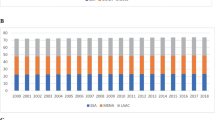Abstract
The aim of this investigation is to analyze the effect of technological innovation on Mexico’s regional economic growth during 1995–2007. It is argued that the inclusion of the spatial dimension in empirical analysis is still a rare practice in Mexico and even in international studies. Such inclusion allows studying the pattern of spatial interaction, the possible effects of spatial diffusion and the estimation of robust parameters. We apply the spatial data analysis methodology that has three components: (a) exploratory analysis, (b) visualization and (c) spatial econometric modeling. The main result suggests that technological innovation has a positive effect on Mexico’s regional economic growth. The empirical evidence also suggests that there is a positive effect coming from cross-border diffusion effects of technological knowledge. It also implies that states with stronger innovation activity benefited from spatial technological externalities and hence faster economic growth.


Similar content being viewed by others
References
Acs Z, Anselin L, Varga A (2002) Patents and innovations counts as a measures of regional production of new knowledge. Res Policy 31:1069–1085
Anselin L (1993) The Moran scatterplot as an ESDA tool to asses local instability in spatial association. West Virginia University, Regional Research Institute, Research Paper 9330
Anselin L (2006) How (not) to lie with spatial statistics. Am J Prev Med 30:3–6
Anselin L, Varga A, Acs Z (1997) Local geographic spillovers between university research and high technology innovations. J Urban Econ 42:422–448
Anselin L, Varga A, Acs Z (2000) Geographic and sectoral characteristics of academic knowledge externalities. Pap Reg Sci 79:435–443
Arbia G (2006) Spatial econometrics, statistical foundations and applications to regional convergence. Springer, Germany
Archibugi D, Pianta M (1992) The technological specialization of advanced countries. A report to the EEC on international science and technology activities. Kluwer, Dordrecht
Audretsch DB (2003) Innovation and spatial externalities. Int Reg Sci Rev 26:167–174
Barro R (1991) Economic growth in a cross section of countries. Q J Econ 106:407–443
Barro R, Sala-i-Martin X (1991) Convergence across states and regions. Brookings Pap Econ Act 22:107–182
Basberg BL (1983) Foreign patenting in the US as a technology indicator. The case of Norway. Res Policy 12(4):227–237
Díaz-Bautista A (2006) Convergence and economic growth considering: human capital and R &D spillovers. Revista Mexicana de Economía y Finanzas 2:127–143
Esquivel G (1999) Convergencia regional en México, 1940–1995. El Trimestre Económico LXVI(4):725–761
Feeny S, Rogers M (2001) Innovation and performance: benchmarking Australian firms. Melbourne Institute, Working Paper number 7/01
Fingleton B (2003) Externalities, economic geography and spatial econometrics: conceptual and modelling developments. Int Reg Sci Rev 26:197–207
Fingleton B (2001a) Equilibrium and economic growth: spatial econometrics models and simulations. J Reg Sci 41:117–148
Fingleton B (2001b) Theoretical economic geography and spatial econometrics: dynamic perspectives. J Econ Geogr 1:201–225
Fischer M, Varga A (2003) Spatial knowledge spillovers and university research: evidence from Austria. Ann Reg Sci 37:303–322
Griliches Z (1979) Issues in assessing the contribution of R &D to productivity growth. Bell J Econ 10:92–116
Griliches Z (1980) Returns to research and development expenditures in the private sector. In: Kendrick J, Vaccara B (eds) New developments in productivity measurement. Chicago University Press, USA
Griliches Z (1986) Productivity, R &D, and the basics research at the firm level in the 1970’s. Am Econ Rev 76:141–154
Griliches Z (1990) Patent statistics as economic indicators: a survey. J Econ Lit 4:1661–1707
Griliches Z (1992) The search for R &D spill-overs. Scand J Econ 94:29–47
Griliches Z (1995) R &D and productivity: econometric results and measurement issues. In: Stoneman P (ed) Handbook of the economics of innovation and technological change. Blackwell, Great Britain
Griliches Z, Mairesse J (1984) Productivity and R &D at the firm level. In: Griliches Z (ed) R &D, patents and productivity. University of Chicago Press, US
Griliches Z, Mairesse J (1990) R &D and productivity growth: comparing Japanese and U.S. manufacturing firms. In: Hulten C (ed) Productivity growth in Japan and the United States, vol 53 de studies in income and wealth. University of Chicago Press, US
Grupp H (1990) Technometrics as a missing link in science and technology indicators. In: Sigurdson J (ed) Measuring the dynamics of technological change. Pinter, London
Krugman P (1991) Increasing returns and economic geography. J Polit Econ 99:483–499
LeSage JP (1999) The theory and practice of spatial econometrics. http://www.spatial-econometrics.com/html/sbook.pdf
LeSage JP, Pace RK (2009) Introduction to spatial econometrics. Taylor and Francis Group LLC, US
Lucas RE (1988) On the mechanics of economic development. J Monet Econ 22:3–42
Ocegueda Hernández JM (2007) Apertura Comercial y Crecimiento Económico en las Regiones de México. Invest Econ LXVI:89–137
OECD (2005) Oslo manual. OECD, Paris
Romer P (1990) Endogenous technological change. J Polit Econ 98:71–102
Schumpeter JA (1934) Theory of economic development. Harvard University Press, Cambridge, MA
Schumpeter JA (1942) Capitalism, socialism and democracy. Harper & Brothers, New York
Solow RM (1956) A contribution of the theory of economic growth. Q J Econ 70:65–94
Solow RM (1957) Technical change and the aggregate production function. Rev Econ Stat 39(3):312–320
Valdivia M (2007) Heterogeneidad Espacial, Convergencia y Crecimiento Regional en México. Trabajo presentado en el XVII Coloquio de Economía Matemática y Econometría, Universidad de Quintana Roo
Author information
Authors and Affiliations
Corresponding author
Rights and permissions
About this article
Cite this article
Torres-Preciado, V.H., Polanco-Gaytán, M. & Tinoco-Zermeño, M.Á. Technological innovation and regional economic growth in Mexico: a spatial perspective. Ann Reg Sci 52, 183–200 (2014). https://doi.org/10.1007/s00168-013-0581-1
Received:
Accepted:
Published:
Issue Date:
DOI: https://doi.org/10.1007/s00168-013-0581-1




